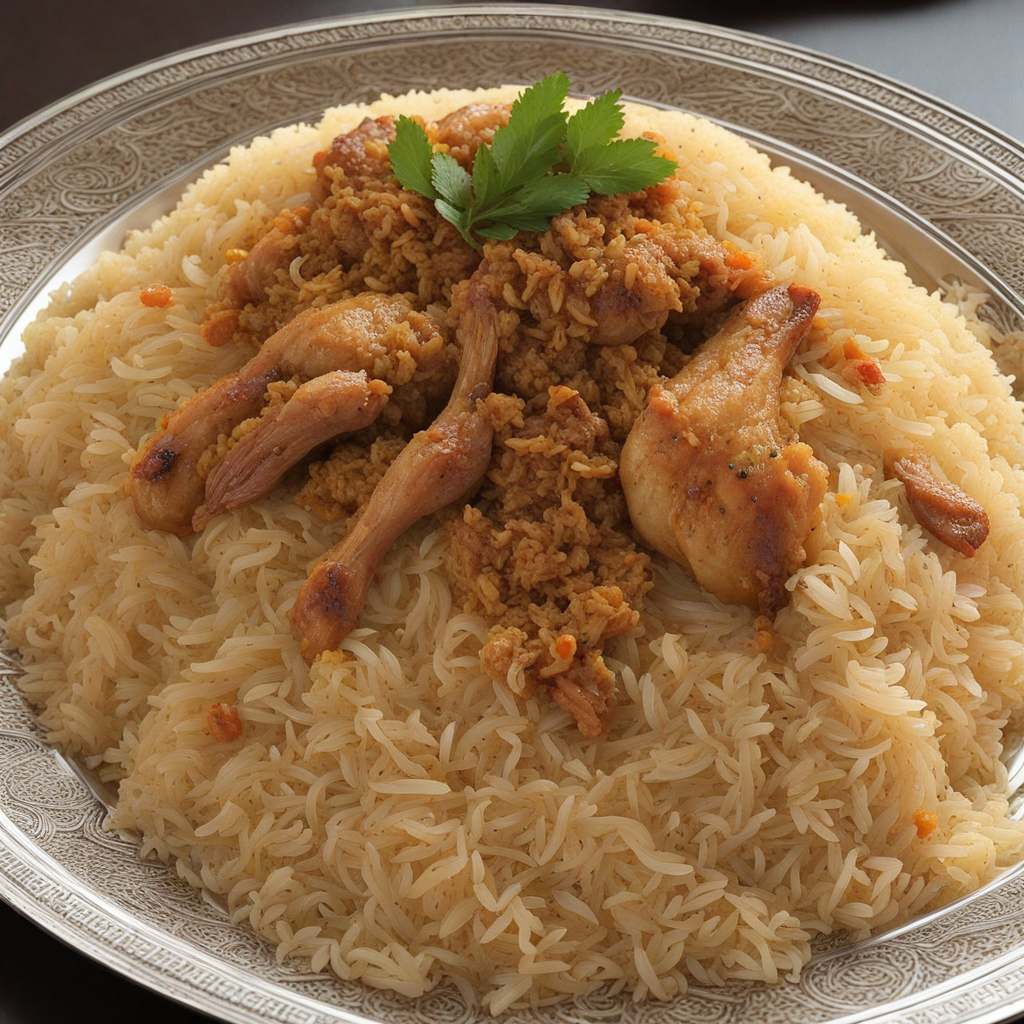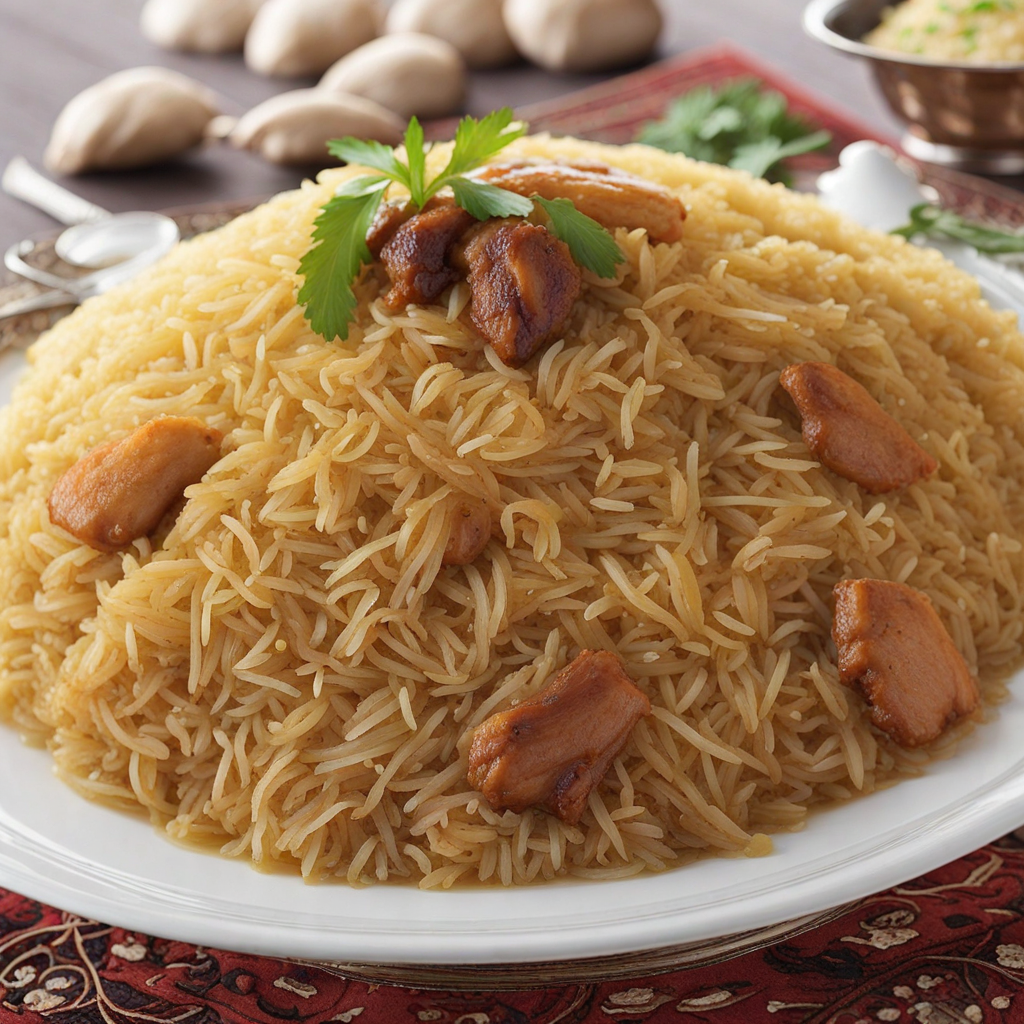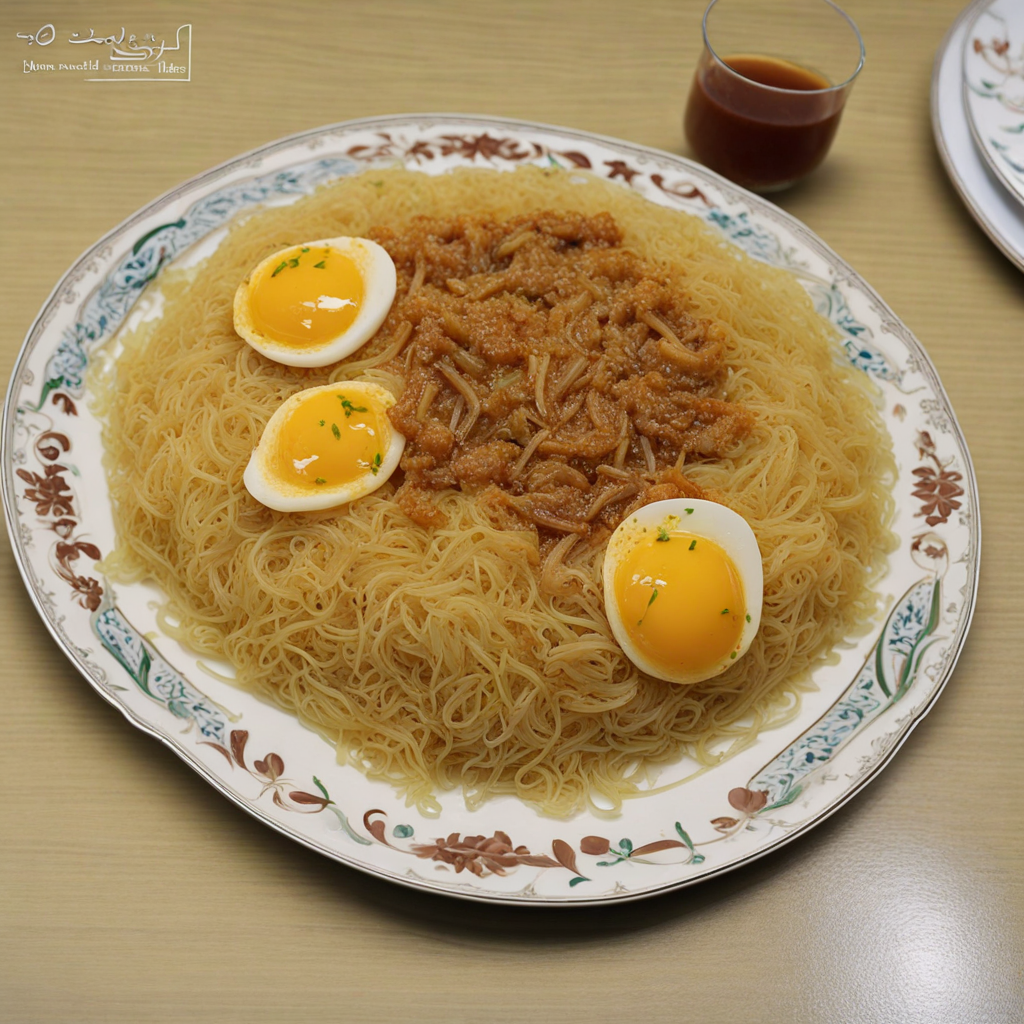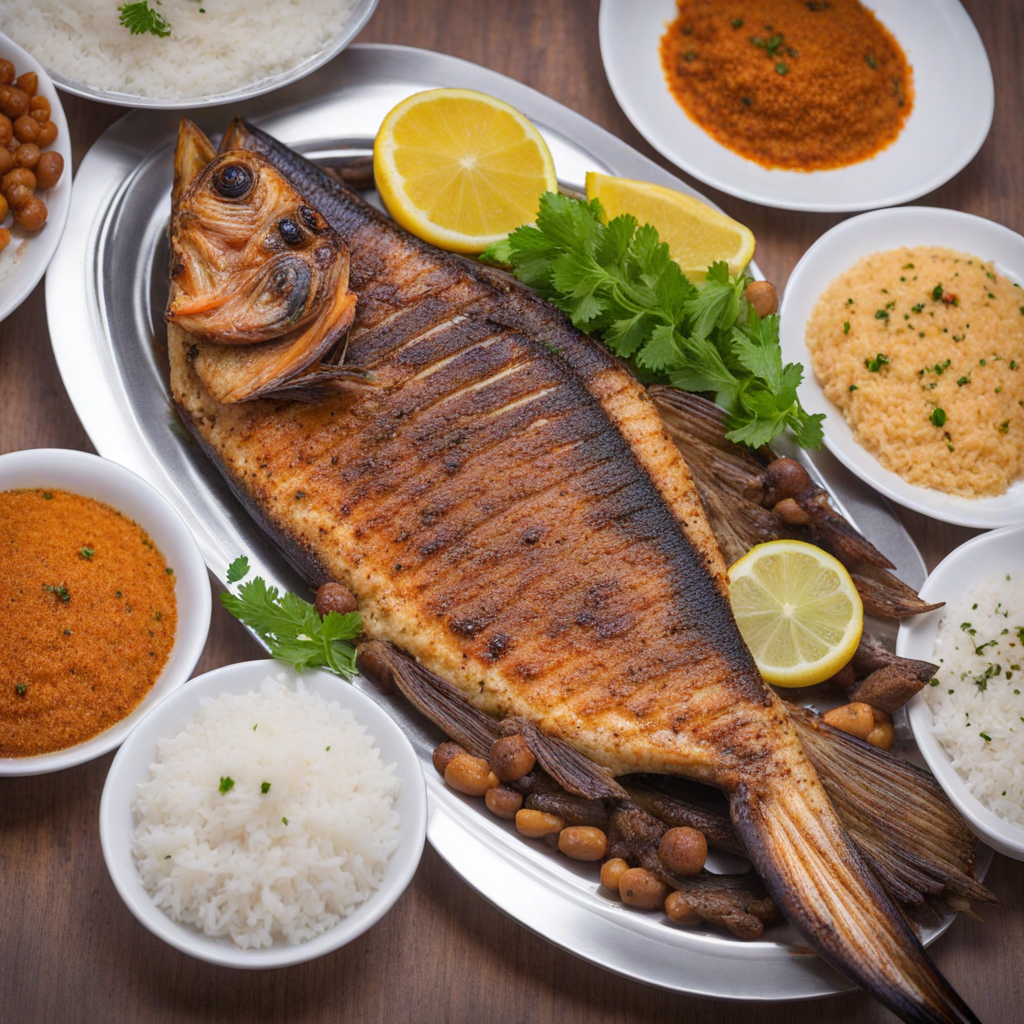Machboos
Machboos is a traditional Bahraini dish that embodies the rich culinary heritage of the Gulf region. It is a fragrant rice dish, similar to biryani, that is often made with basmati rice, infused with a blend of spices such as turmeric, saffron, cardamom, and cinnamon. The rice is typically cooked in a rich broth, usually made from chicken, lamb, or fish, allowing it to absorb the deep flavors of the meat and spices. The dish is often garnished with fried onions, nuts, and raisins, adding both texture and sweetness to the savory profile. The preparation of Machboos involves marinating the meat in a mix of spices and sometimes yogurt, enhancing its taste before it is slowly cooked until tender. The cooking process usually involves layering, where the meat is placed over the partially cooked rice, allowing the flavors to meld beautifully. The result is a hearty meal that is both aromatic and visually appealing, often served on a large platter for sharing. Accompanying sides may include tangy salads and tangy sauces, which balance the richness of the dish. Machboos is not just a meal; it is a cultural experience that brings family and friends together. The communal aspect of serving Machboos showcases the Bahraini tradition of hospitality, where sharing food is a sign of love and connection. Each bite offers a delightful explosion of flavors, making it a must-try for anyone looking to explore the exquisite tastes of Bahraini cuisine.
How It Became This Dish
The Culinary Journey of مجبوس: Bahrain’s Beloved Dish Maqbous, or مجبوس, is a dish that encapsulates the essence of Bahrain’s rich cultural tapestry and culinary heritage. With its aromatic spices and tantalizing flavors, مجبوس has become a celebrated symbol of Bahraini cuisine, enjoyed by locals and visitors alike. Its history is a fascinating chronicle of trade, cultural exchange, and regional influences that have shaped its evolution over the centuries. Origins: The Spice Route and Cultural Exchange The origins of مجبوس can be traced back to the early days of the Arabian Peninsula's interactions with neighboring regions. Bahrain, strategically located in the Persian Gulf, has long been a hub for trade and cultural exchange. As a significant stop along the ancient Spice Route, the island welcomed merchants and travelers from various cultures, including Persia, India, and East Africa. These interactions brought not only spices but also culinary techniques and traditions that would influence the local cuisine. The dish itself is often associated with rice-based meals, a staple in many Middle Eastern countries. The use of basmati rice in مجبوس reflects the influence of Indian cuisine, where rice is a fundamental component. The spices that define مجبوس, such as saffron, cardamom, and black lime (loomi), are reminiscent of the Persian and Indian flavors that permeated Bahraini cooking. Cultural Significance: A Symbol of Hospitality and Community Mجبوس holds a special place in the hearts of Bahrainis, embodying the spirit of hospitality that is central to the culture. Traditionally served during communal gatherings, celebrations, and family feasts, مجبوس is more than just a meal; it is a symbol of togetherness and sharing. Whether at weddings, religious celebrations, or holiday feasts like Eid, مجبوس brings people together, fostering connections and strengthening community bonds. The preparation of مجبوس is often a communal affair, with family members contributing to the cooking process. This collaborative approach not only enhances the dish’s flavors but also reinforces familial ties and traditions. In Bahraini homes, it is common to see multiple generations participating in the cooking, passing down recipes and techniques that have been honed over decades. Ingredients and Preparation: A Culinary Masterpiece At its core, مجبوس is a dish made with rice, meat (typically chicken, lamb, or fish), and an array of spices. The preparation begins with marinating the meat in a blend of spices, which may include cumin, coriander, and turmeric, among others. Saffron is often used to infuse the dish with a distinctive yellow hue, while black lime adds a unique tanginess that elevates the overall flavor profile. The cooking process involves sautéing onions and garlic, followed by the addition of the marinated meat. Once the meat is browned, water is added, and the mixture is allowed to simmer until the meat is tender. The rice is then added to the pot, absorbing the rich flavors of the broth and spices. The dish is typically garnished with fried onions, raisins, and nuts, which add texture and sweetness. Over time, variations of مجبوس have emerged, reflecting local preferences and available ingredients. Seafood مجبوس, for example, showcases the abundant fish from Bahrain’s waters, while vegetarian versions highlight the use of seasonal vegetables and legumes. These adaptations demonstrate the versatility of the dish and its ability to evolve with changing culinary trends. Historical Development: From Traditional Roots to Modern Interpretations As Bahrain underwent significant social and economic changes throughout the 20th century, so too did its culinary landscape. Globalization and increased access to international ingredients and cooking techniques have influenced the way مجبوس is prepared and enjoyed. While traditional recipes remain cherished, contemporary chefs are experimenting with modern twists, incorporating new flavors and presentation styles. The rise of the tourism industry in Bahrain has also contributed to the popularity of مجبوس. As visitors flock to the island to experience its rich history and culture, local restaurants have embraced the opportunity to showcase Bahrain’s culinary heritage. Many establishments offer مجبوس as a signature dish, often accompanied by traditional Bahraini bread and a variety of side dishes, such as salads and dips. At the same time, home cooks continue to uphold the traditions of مجبوس, ensuring that the dish retains its cultural significance. Family gatherings often revolve around preparing and sharing this iconic meal, with recipes passed down through generations. Bahraini expatriates living abroad often find solace in cooking مجبوس, as it evokes memories of home and serves as a connection to their roots. A Global Culinary Icon: مجبوس Beyond Bahrain In recent years, مجبوس has gained recognition beyond the borders of Bahrain, becoming a culinary ambassador for Bahraini culture. Food festivals, cultural exhibitions, and cooking classes have introduced this delectable dish to a wider audience, sparking interest in its flavors and history. Chefs and food enthusiasts alike have begun to explore the intricacies of مجبوس, experimenting with fusion styles that blend Bahraini traditions with other global cuisines. Social media platforms have also played a pivotal role in popularizing مجبوس, with food bloggers and influencers showcasing their own takes on this classic dish. The vibrant colors and aromatic spices make for visually appealing content, drawing attention to the artistry involved in its preparation. As a result, مجبوس is not only celebrated for its taste but also for its visual appeal, further solidifying its status as a culinary icon. Conclusion: A Dish Steeped in History and Tradition Mجبوس is more than just a meal; it is a reflection of Bahrain’s history, culture, and community spirit. From its origins along the Spice Route to its modern interpretations, this beloved dish continues to evolve while remaining anchored in tradition. As a symbol of hospitality and togetherness, مجبوس holds a cherished place in the hearts and homes of Bahrainis, ensuring that its legacy endures for generations to come. Whether enjoyed at a family gathering or a local restaurant, مجبوس invites everyone to partake in the rich tapestry of Bahraini culture. The dish stands as a testament to the power of food in connecting people, telling stories, and celebrating heritage, making it an enduring and cherished element of Bahrain’s culinary landscape.
You may like
Discover local flavors from Bahrain







